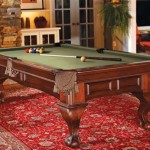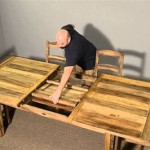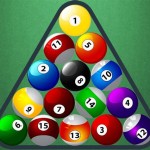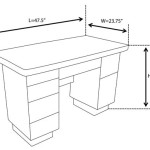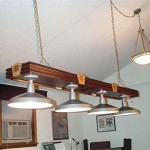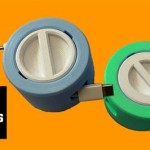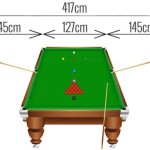What Is The Length Of A Full Size Snooker Table In Feet And Inches?
Snooker, a game of precision, strategy, and controlled aggression, is played on a distinctive table that forms the very foundation of the sport. Understanding the dimensions of a full-size snooker table is crucial for both players and enthusiasts alike. These dimensions are not arbitrary; they are codified in the official rules of the game and contribute significantly to the unique challenges and strategic considerations that snooker presents.
The purpose of this article is to provide a comprehensive explanation of the length of a full-size snooker table, expressed in feet and inches. We will delve into the official specifications, explore the rationale behind these dimensions, and discuss the variations that may occur within acceptable tolerances. Furthermore, we will examine the implications of these dimensions on gameplay and the overall character of the sport.
The dimensions of a snooker table significantly influence the angles available to the player, the distances required for long pots, and the overall flow of the game. Alterations, even seemingly minor ones, can drastically change the nature of the sport, rendering it fundamentally different from the game as it is universally understood and played in professional settings. Therefore, adherence to the official specifications is paramount for maintaining the integrity of snooker.
Official Length Specification
The officially prescribed length of a full-size snooker table is 12 feet. This measurement is taken from the facing of the cushions on one end of the table to the facing of the cushions on the opposite end. While this measurement is expressed simply as 12 feet, it is important to understand the context of "feet" in this regard. For clarity, this can also be stated as 144 inches. The 12-foot length is not merely a suggestion; it is a core component of the standardized rules laid down by governing bodies such as the World Professional Billiards and Snooker Association (WPBSA).
The length specification is inextricably linked to the width specification, which is six feet. The resulting 2:1 aspect ratio is crucial for dictating the types of shots that are possible, the degree of difficulty in executing those shots, and the positional play that is central to successful snooker. Any deviation from this ratio would necessitate significant adjustments to playing styles and strategies.
Consider, for instance, how a longer table would affect the game. Long pots, already a challenging aspect of snooker, would become even more difficult. The cue ball would lose more energy traveling the increased distance, leading to less predictable results. Positional play would also be affected, as the player would have to adjust their calculations to account for the greater distances involved.
Conversely, a shorter table would make the game less demanding. Long pots would become easier, and positional play would be less critical. The overall skill ceiling of the game would be lowered, and the strategic depth would be significantly reduced.
The official 12-foot length, therefore, represents a carefully considered balance between difficulty and strategic depth, ensuring that snooker remains a challenging and rewarding game.
Tolerances and Acceptable Variations
While the official specification states that a full-size snooker table should be 12 feet long, it is accepted that minor variations may occur. These variations are typically related to the manufacturing process and the natural properties of the materials used to construct the table. The WPBSA guidelines specify a tolerance range within which these variations are deemed acceptable.
The acceptable tolerance is usually defined as a small percentage of the overall length. While exact figures may vary slightly depending on the specific rule set being applied, it is generally accepted that the length should be within approximately half an inch of the specified 12 feet. This means the actual length could be marginally above or below 144 inches (12 feet), but only by a very small amount. A larger tolerance, for example, could introduce an unacceptable level of inconsistency to the game.
These tolerances are in place to accommodate unavoidable variations in manufacturing and material properties. Wood, for example, can expand and contract depending on temperature and humidity. Therefore, strict adherence to a precise measurement is often impractical. The tolerance range allows for these minor fluctuations without compromising the integrity of the game.
It is crucial to note that these tolerances are not an invitation to disregard the official specifications. Manufacturers are expected to adhere to the 12-foot length as closely as possible. The tolerance range merely provides a small margin of error to account for unavoidable variations. Tables that fall outside of this tolerance range are not considered to be full-size snooker tables and should not be used in official competitions.
The responsibility for ensuring that a snooker table meets the required specifications typically falls on the tournament organizers or governing body. They may use calibrated measuring tools to verify the length and width of the table before a competition begins. If a table is found to be outside of the acceptable tolerance range, it may be rejected for use in the tournament.
Impact on Gameplay and Strategy
The 12-foot length of a snooker table has a profound impact on gameplay and strategy. It dictates the distances that players must cover to execute shots, the angles that are available to them, and the degree of difficulty in controlling the cue ball. Understanding these implications is essential for developing a successful snooker game.
The length of the table directly affects the difficulty of long pots. The greater the distance between the cue ball and the object ball, the more challenging it becomes to accurately judge the required angle and apply the correct amount of power. Long pots require a high degree of precision and control, and they are often a decisive factor in determining the outcome of a frame.
Furthermore, the length of the table influences the effectiveness of certain types of shots, such as screw shots and side spin shots. These shots rely on the cue ball traveling a significant distance after making contact with the object ball. The longer the table, the more opportunity there is for the cue ball to be affected by spin and friction, allowing the player to exert greater control over its trajectory.
Positional play is another aspect of the game that is heavily influenced by the length of the table. The player must carefully consider the position of the cue ball after each shot, taking into account the distances to the other balls and the available angles. The longer the table, the more challenging it becomes to accurately predict the cue ball's trajectory and position it in the desired location. This requires a deep understanding of the physics of the game and the ability to visualize the potential outcomes of each shot.
The 12-foot length also contributes to the strategic complexity of snooker. Players must carefully assess the layout of the balls and develop a plan for clearing the table. This often involves a combination of attacking shots and defensive shots, as well as the strategic use of snookers and safety plays. The length of the table influences the effectiveness of these strategies, dictating the types of shots that are possible and the degree of risk involved.
In summary, the 12-foot length of a full-size snooker table is a crucial element of the game. It shapes the playing experience, dictates the strategies that are employed, and contributes to the overall challenge and strategic depth of snooker. A meticulous understanding of its significance is essential for anyone seeking to excel in this captivating sport.

What Size Room Will I Need For My Snooker Table Liberty

Snooker And Pool Table Room Size Guide

The Official Size Of A Pool Table Canadian Home Leisure

Snooker Table Layout Dynamic Billiard Mississauga

Measure Your Room For A Pool Table Royal Billiard Recreation

Pool Table Size Chart Moving The Experts

Pool Table Room Size Calculator

Room Size Pooltables Com

What Size Room Will I Need For My Snooker Table Liberty

Fcsnooker Snooker Table Hole Centres For The Legs
Related Posts

